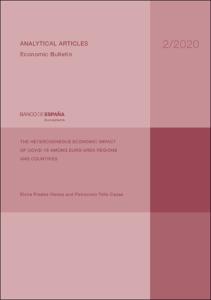Registro completo de metadatos
| Campo DC | Valor |
|---|---|
| dc.contributor.author | Prades, Elvira |
| dc.contributor.author | Tello-Casas, Patrocinio |
| dc.coverage.spatial | España |
| dc.coverage.spatial | Alemania |
| dc.coverage.spatial | Francia |
| dc.coverage.spatial | Italia |
| dc.date.accessioned | 2020-07-02T10:12:15Z |
| dc.date.available | 2020-07-02T10:12:15Z |
| dc.date.issued | 2020-05-27 |
| dc.identifier.uri | https://repositorio.bde.es/handle/123456789/13069 |
| dc.description | Artículo de revista |
| dc.description.abstract | The global spread of COVID-19 and, above all, the social distancing measures adopted to contain the health crisis have resulted in a significant standstill in economic activity in most economies. The economic impact on different countries’ or regions’ economies may vary significantly depending on their respective productive structures and will also be influenced by the crosssectoral customer-supplier relationships in the domestic and international supply chains. This article investigates how the impact of the shock triggered by COVID-19 may vary depending on these two characteristics: differences in the productive structure and cross-sectoral connections. First, the impact of two different scenarios envisaged for Spain on the value added of its different regions (Comunidades Autónomas) is quantified. Then, those same scenarios are used to estimate the impact of an identical shock on the largest euro area countries (Germany, France, Italy and Spain). The findings confirm that the effects of the restrictions imposed on economic activity in Spain to contain the pandemic vary according to the region on account of the different productive structures and cross-sectoral relationships. Broadly speaking, it appears that the estimated impact is significantly higher in the regions most exposed to the sectors related to accommodation and food service activities, such as the island regions. The impact would also be high in other regions, which tend to be those where the manufacturing of vehicles is of particular importance, due not only to the closure of production plants, but also to the spillover effect on other sectors. By applying to the main euro area economies the same degree of sectoral shutdowns as that observed in the Spanish economy, the impact on Germany, France and, to a lesser extent, Italy is comparatively smaller than in Spain. The differences in productive structure and cross-sectoral connections render the Spanish economy relatively more vulnerable to a common shock such as the current pandemic due to its greater reliance on those sectors particularly stricken by the social distancing measures. |
| dc.format.extent | 15 p. |
| dc.language.iso | en |
| dc.publisher | Banco de España |
| dc.relation.ispartof | Economic Bulletin / Banco de España, 2/2020 |
| dc.relation.hasversion | Versión en español 123456789/12701 |
| dc.rights | Reconocimiento-NoComercial-CompartirIgual 4.0 Internacional (CC BY-NC-SA 4.0) |
| dc.rights | In Copyright - Non Commercial Use Permitted |
| dc.rights.uri | https://creativecommons.org/licenses/by-nc-sa/4.0/deed.es_ES |
| dc.rights.uri | http://rightsstatements.org/vocab/InC-NC/1.0/ |
| dc.subject | Common shocks |
| dc.subject | Lockdown |
| dc.subject | COVID-19 |
| dc.subject | Input-output relationships |
| dc.subject | EUREGIO |
| dc.subject | Regional analysis |
| dc.subject | Economy of the European Union |
| dc.subject | Economic situtation |
| dc.title | The heterogeneous economic impact of COVID-19 among euro area regions and countries |
| dc.type | Artículo |
| dc.identifier.bdebib | 000469118 |
| dc.identifier.bdepub | ECBU-2020-2B-art17 |
| dc.subject.bde | Structural analysis |
| dc.subject.bde | Fluctuaciones y ciclos económicos |
| dc.subject.bde | Economía internacional |
| dc.subject.bde | Presupuesto y contabilidad pública |
| dc.subject.bde | Integración económica europea |
| dc.publisher.bde | Madrid : Banco de España, 2020 |
| dc.subject.jel | E01 |
| dc.subject.jel | E32 |
| dc.subject.jel | F14 |
| dc.subject.jel | F15 |
| dc.subject.jel | H72 |












